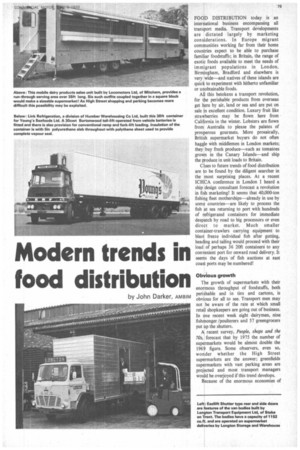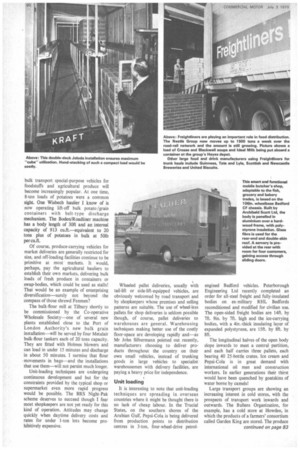Modern trends in food distribution
Page 81

Page 82

Page 85

If you've noticed an error in this article please click here to report it so we can fix it.
by John Darker, AMBIM
FOOD DISTRIBUTION today is an international business encompassing all transport media. Transport developments are dictated largely by marketing considerations. In Europe migrant communities working far from their home countries expect to be able to purchase familiar foodstuffs; in Britain, the range of exotic foods available to meet the needs of immigrant populations in London, Birmingham, Bradford and elsewhere is very wide—and natives of these islands are quick to experiment with hitherto unfamiliar or unobtainable foods.
All this betokens a transport revolution, for the perishable products from overseas get here by air, land or sea and are put on sale in excellent condition. Luxury fruit like strawberries may be flown here from California in the winter. Lobsters are flown from Australia to please the palates of prosperous gourmets. More prosaically, British supermarket buyers do not often haggle with middlemen in London markets; they buy fresh produce—such as tomatoes grown in the Canary Islands—and ship the produce in unit loads to Britain.
Clues to future trends of food distribution are to be found by the diligent searcher in the most surprising places. At a recent ICHCA conference in London I heard a ship design consultant forecast a revolution in fish marketing! It seems that 40,000-ton fishing fleet motherships—already in use by some countries—are likely to process the fish at sea returning to port with hundreds of refrigerated containers for immediate despatch by road to big processors or even direct to market. Much smaller container-trawlers carrying equipment to blast freeze individual fish after gutting, heading and tailing would proceed with their load of perhaps 36 20ft containers to any convenient port for onward road delivery. It seems the days of fish auctions at east coast ports may be numbered!
Obvious growth The growth of supermarkets with their enormous throughput of foodstuffs, both perishable and in tins and cartons, is obvious for all to see. Transport men may not be aware of the rate at which small retail shopkeepers are going out of business. In one recent week eight dairymen, nine fishmonger /poulterers and 57 greengrocers put up the shutters.
A recent survey, People, shops and the 70s, forecast that by 1975 the number of supermarkets would be almost double the 1969 figure. Some observers, even so, wonder whether the High Street supermarkets are the answer; greenfields supermarkets with vast parking areas are projected and most transport managers would be overjoyed if this trend develops.
Because of the enormous economies of
bulk transport special-purpose vehicles for foodstuffs and agricultural produce will become increasingly popular. At one time, 8-ton loads of potatoes were a common sight. One Wisbech haulier I know of is now operating lift-off bulk potato /grain containers with belt-type discharge mechanism. The Boden/Roadliner machine has a body length of 30ft and an internal capacity of 913 cu.ft.—equivalent to 20 tons plus of potatoes in bulk at 501b per cat.
Of course, produce-carrying vehicles for market deliveries are generally restricted for size, and off-loading facilities continue to be primitive at most markets. It would, perhaps, pay the agricultural hauliers to establish their own markets, delivering bulk loads of fresh produce in containers or swap-bodies, which could be used as stalls! That would be an example of enterprising diversification—surely not beyond the compass of those shrewd Penmen?
The bulk-flour mill at Tilbury shortly to be commissioned by the Co-operative Wholesale Society—one of several new plants established close to the Port of London Authority's new bulk grain installation—will be served by four Metalair bulk-flour tankers each of 20 tons capacity. They are fitted with Holmes blowers and can load in under 15 minutes and discharge in about 50 minutes. I surmise that flour • movements in bags—and the installations that use them—will not persist much longer.
Unit-loading techniques are undergoing continuous development and but for the constraints provided by the typical shop or supermarket even more rapid progress would be possible. The BRS Night-Pak scheme deserves to succeed though I fear most shopkeepers are not yet ready for this kind of operation. Attitudes may change quickly when daytime delivery costs and rates for under 1-ton lots become prohibitively expensive.
Wheeled pallet deliveries, usually with tail-lift or side-lift-equipped vehicles, are obviously welcomed by road transport and by shopkeepers whose premises and selling patterns are suitable. The use of wheel-less pallets for shop deliveries is seldom possible though, of course, pallet deliveries to warehouses are general. Warehousing techniques making better use of the costly floor-space are developing rapidly and—as Mr John Silbermann pointed out recently, manufacturers choosing to deliver products throughout the country on their own small vehicles, instead of trunking goods in large vehicles to specialist warehousemen with delivery facilities, are paying a heavy price for independence.
Unit loading It is interesting to note that unit-loading techniques are spreading in overseas countries where it might be thought there is no lack of cheap labour. In the Trucial States, on the southern shores of the Arabian Gulf, Pepsi-Cola is being delivered from production points to distribution centres in 3-ton, four-wheel-drive petrol
engined Bedford vehicles. Peterborough Engineering Ltd recently completed an order for all-steel freight and fully-insulated bodies on ex-military RHL Bedfords reconditioned and modified for civilian use. The open-sided freight bodies are 14ft. by 7ft. 9in. by 7ft. high and the ice-carrying bodies, with a 4in.-thick insulating layer of expanded polystyrene, are 15ft. by 8ft. by 8ft.
The longitudinal halves of the open body slope inwards to meet a central partition, and each half carries three pallets, each bearing 40 25-bottle crates. Ice cream and Pepsi-Cola is in great demand with international oil men and construction workers. In earlier generations their thirst would have been quenched by goatskins of water borne by camels!
Large transport groups are showing an increasing interest in cold stores, with the prospects or transport work inwards and outwards. The Bullens Organization, for example, has a cold store at Howden, in which the products of a farmers' consortium called Garden King are stored. The produce is distributed through Muirheads, a marketing agency for farm produce operating throughout England south of the Humber.
A Sullen Transport Group subsidiary, Hewson Brothers, of Howden, provides Garden King with refrigerated transport facilities from the processing plant to the user /packer as well as conventional transport when required from farms to the plant. Hewson also undertakes the deliveries ex cold store as required.
When delivering to an external processing plant. the vegetables are carried in bins, iced when necessary, on normal platform trailers. Processed crops are delivered from the cold store in refrigerated vehicles, either pre-packed or in bulk, in 1-ton minimum drops.
T1R specification
Hewson's refrigerated vehicles are all built to TIR specification and this proves useful for Garden King liaison with the Dutch firm of Gotra, based in Utrecht. Hewson sends over a tractor-trailer unit which picks up out-of-season vegetables for the UK market after discharging British produce for foreign consumption. No doubt as Britain becomes more involved with the Common Market such arrangements will become common place.
Mobile food shops, often rather primitive conversions, are still popular in many British towns. There is a tendency for small shops in residential streets to close much earlier than was once the case, and I have seen mobile shops hard at work quite late at night. Their operations are often hampered by rows of parked cars.
A mobile dairy products sales unit recently built by Locomotors Ltd, of Mitcham, for a major dairy complex in Austria, is an interesting development. To be used primarily at fairs, festivals and outdoor exhibitions, it consists of a 7-ton Bedford TK towing unit and a four-wheel trailer, coupled together to make a run through serving area 35ft. Sin, long.
The upper right hand side of the body on both units lifts up to form a canopy over the serving counter, and there is a drop-down counter on the outside. Forced air ventilation is provided through adjustable air outlets, and with an extractor fan air flow is created across the body. Internal fittings include an electric refrigerator, cooker, sink unit with hot and cold water, extensive display shelving, cupboards and counter area, in which is incorporated refrigerated storage compartments. A folding table and chairs are part of the outfit. Fluorescent lighting is incorporated as well as a centrifugal pump for water supplies, power coming from the mains.
This is an interesting example of a British coachbuilding firm winning a highly competitive export order.
Food carrying vehicles, incidentally, are sometimes delivered from Britain by road.
A £6000 vehicle was delivered recently to Iran by Holmes Travel Ltd, of Cheltenham, which specializes in overland delivery. This was a refrigerated vehicle with a Smith's "Litex" body on a Leyland Albion Chieftain chassis. The 18ft. long van body finished in "marbled" aluminium was fitted with a Thermo-King refrigeration unit which will keep internal temperature down to Odeg F in desert temperatures of 110 degrees.
Joloda pallet loading goes from strength to strength with over 12,000 vehicles fitted in 28 countries. To meet stringent hygiene regulations in Germany it is possible to specify Joloda tracks in stainless steel. Extending tracks which are in portable 411. lengths and are cross-linked or held parallel by simple floor attachments enable pallets to be easily loaded into containers, fork-lift trucks depositing the pallet load on to the tracks. A 14-ton single pallet load almost 20ft. long has been rolled into a container in under a minute. Given a suitable warehouse or shop-site it is not hard to see the money savings with this kind of high-productivity system.
Great ingenuity is being shown by a number of manufacturers of vehicleand container-loading systems. Pelco Ltd, of Handcross, Sussex, which has successfully introduced Rolamat loading systems to some road haulage operators, has done a lot of development work on its inflatable pallet lifting device used in conjunction with lengths of Rolamat. The latest version, I gather, is likely to incorporate nothing more complicated than a fire hose, coupled together in 10ft, lengths using quick-release bayonet couplings. The system can be powered by vehicle compressor or air bottle and Pelco is hopeful that the complete system cost will be more than competitive.
Distribution costs With food distribution costs from factory to point of sale running as much as 25 per cent of total costs, efficiency in operation—by budgetary control, incentive schemes, advanced forms of computer route planning, and so on—are called for. Mechanical handling aids fitted to the vehicle itself are most profitable on short-distance shuttle operations.
Mechanical loading and unloading aids at terminals, larger capacity or special-purpose vehicles, above all, better vehicle utilization, over seven days a week, night and day, is ideally called for, if the operational pattern makes this possible.
Growth areas, such as refrigeration, are easy to foresee. It needs no emphasis to point to the likely more stringent standards of hygiene that will be enforced in future years. The image of food distributors, even of packaged or canned products, is not enhanced by dirty vehicles. Drivers wearing clean over-clothing or special uniforms should be mandatory. One thing is safely predicted: food distribution is most unlikely to get cheaper.
At all levels, not least in management, training for efficiency will be continuously necessary, and food transport and distribution managers will need to note techniques developed in other countries.




































































































































































